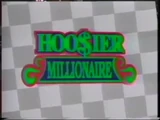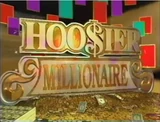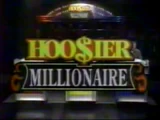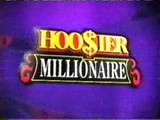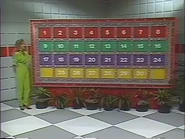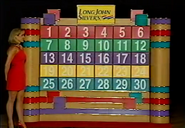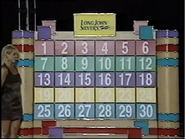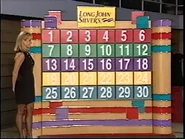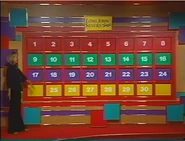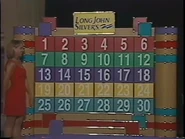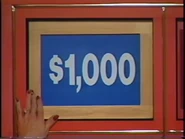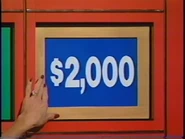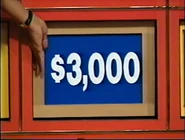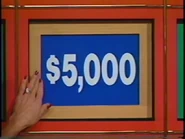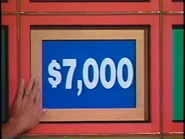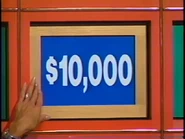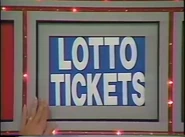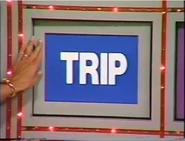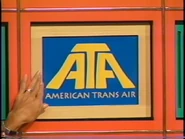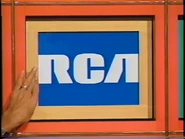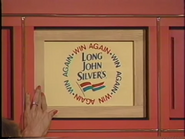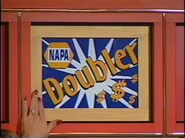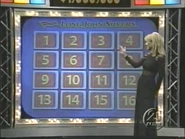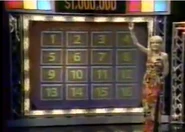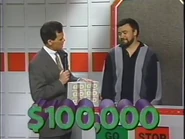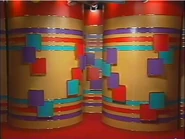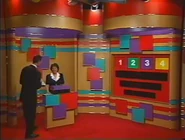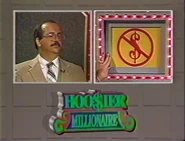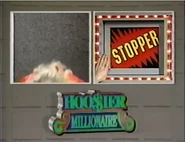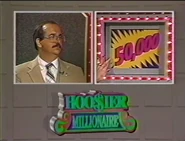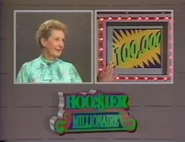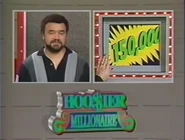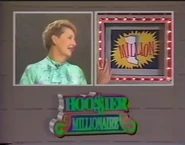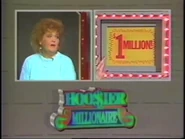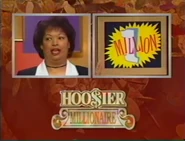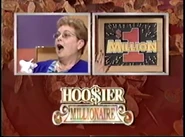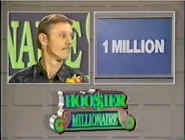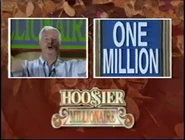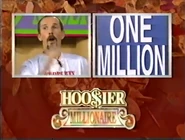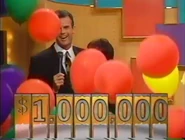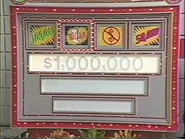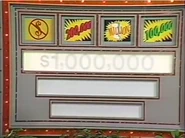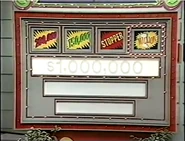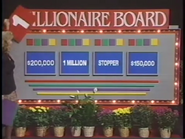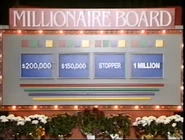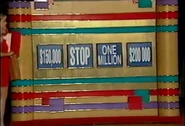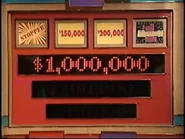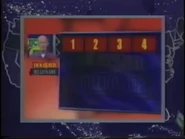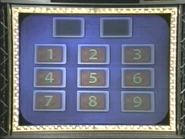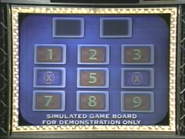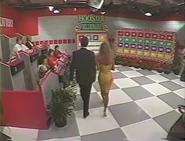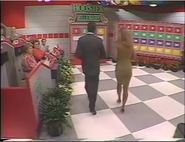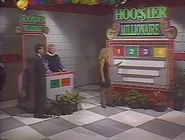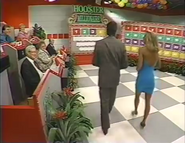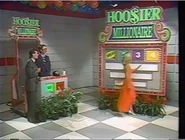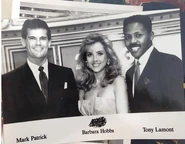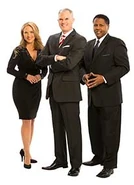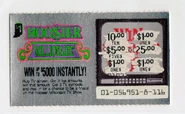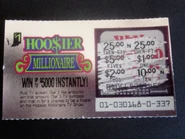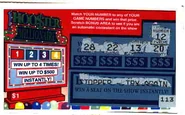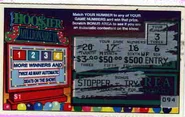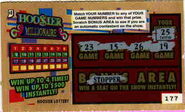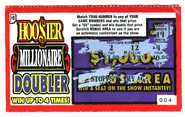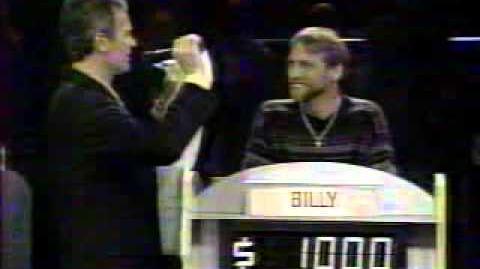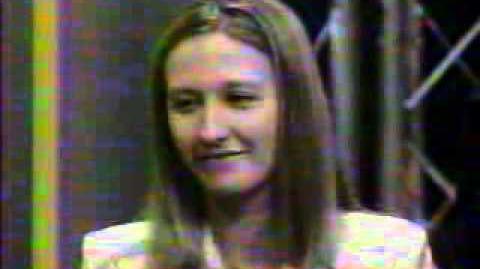| Hosts | |
| Mark Patrick (1989-2003, 2014) Cody Stark (2003-2004) Tony Lamont (2004-2005) | |
| Co-Hosts | |
| Barbara Hobbs (1989-2003, 2014) Catt Sadler (2003-2005) | |
| Announcers | |
| Tony Lamont (1989-2004, 2014) Andrew Rees (2004-2005) | |
| Broadcast | |
| Syndicated (Indiana [& outlying areas]): 10/28/1989 - 12/31/2005 Syndicated (Indiana Area) Special: 8/23-24/2014 | |
| Packagers | |
| WTTV Indianapolis (1989-1996, 1999-2003) WNDY Indianapolis (1996-1999) Producers Plus (2003-2005) WXIN Indianapolis (2014) | |
(The New) Hoosier Millionaire is a clone of $100,000 Fortune Hunt for the state of Indiana.
Rules
Main Game
10/28/89-01/01/00, 4/27/02-5/31/03
Six contestants each played three rounds and chose at least three numbers (one for each round) from a game board with 30 squares numbered 1-30. The dollar amounts ranged from $1,000-$10,000 (with $1,000 and $2,000 being the most common). There were also two bonus prizes (typically 5,000 Hoosier Lottery Scratch-Off tickets and a trip sponsored by ATA) on the board that "did not count toward a contestant's cash prize total" (that is, the contestant got to pick again until uncovering a number with a dollar amount). In some episodes, only one bonus prize was on the Board, mainly the instant tickets, and in 1996-97, there were three bonus prizes including the RCA Home Package. Round 3 eliminates the four contestants with the lowest dollar amounts until there were only two contestants left who both advanced to the playoff round. The contestant who ended with the most money moved on to the bonus round. All six contestants keep whatever money they earned (which was guaranteed to be at least $3,000). In 1992, a "Doubler" square was added to the game board which doubled whatever dollar amount was next picked.
In the playoff, the players build on their previous scores, each picking until the opponent(s) can't catch up.
1/8/00-4/20/02
Same idea, except that there were three players per game, 16 squares, and two rounds followed by the playoff. Also, finding a bonus added $1,000 to the score.
Bonus Round (Millionaire Round)
Version 1 (1989–1990): The winning contestant is presented a board with four numbers. Behind each number are three green dollar signs and a red "no dollar sign" (called the "Stopper", or as Mark will call it, "The Non-winning Symbol"). Picking the first dollar sign won the contestant $50,000. The contestant could then stop and take the $50,000 or risk it for a try at the second green dollar sign. Picking the second dollar sign earned the contestant another $50,000. The contestant could then risk it by picking from the two remaining numbers; picking the third dollar sign won the contestant the $1,000,000 grand prize. Picking the Stopper symbol would lose the $50,000/$100,000 risked.
Version 2 (1990–01/01/00, 4/27/02-5/31/03): Same as version 1, but the three green dollar signs were replaced by $50,000, $100,000, and $1,000,000 symbols. This meant that the contestant could now win $1,000,000 on the first selection. In the mid-1990s, the two smaller prizes were increased to $150,000 (introduced in 1992) and $200,000 (introduced in 1991). Beginning on 1/22/94, the contestant was presented with a glass case of $100,000 cash that they could take and forget about the bonus round (again, by hitting the red stop button to stop or green button to go on) or risk it for one of the bigger cash prizes. Again, picking the Stopper symbol (which was changed by this point to a matching exploding graphic like the cash prizes) lost all bonus round money. It was also by this point that the contestant was presented his/her winnings with a big check; previously only those who won the $1,000,000 grand prize was presented with the big check at the end.
Version 3 (Millionaire Match, 1/8/00-4/20/02): Nine squares are presented. Behind four of them are the first half of a dollar bill, "$50", "$100", "$150", and "$250". Behind three are the ",000"'s, and behind two are Stoppers. Forming a complete bill won that prize, finding both Stoppers ended the round, and finding two ",000"'s on the first two pics won $1,000,000.
In all pre-Hysteria formats, finding the Stopper(s) won the player an additional 1,000 Hoosier Lottery tickets.
Hysteria!
On 6/7/03, new hosts (Cody Stark & Catt Sadler) and a new format debuted, in which the million was now awarded every 13 weeks. On 10/23/04, Tony Lamont replaced Stark as co-host.
Main Game
While the basic format (6 players & 30 numbers) remained, the following changes were made:
- The minimum prize was doubled to $6,000.
- The $1,000 squares were replaced with $2,000 squares and additional bonus prizes ranging in value from $2,000-$5,000, these bonuses are added to the contestant's score.
- A new strategy in the preliminary round allowed the contestant who reveals the "Doubler" square to either use it immediately on his next selection, or to hold it to use on a selection later in the game.
Hoosier Millionaire Doubler
Seven spaces are presented, spelling out the word "DOUBLER". Behind them are three "doubler" squares, one "tripler" square and three "stoppers." If the player reveals a "doubler"/"tripler", their front game score is increased accordingly. It's possible for a player to hit all three "doubler" spaces followed by the "tripler", but if a stopper is found at any time, the player's total reverts back to the amount won in the front game.
During the first six weeks of the season, the winner of each "Doubler" game was placed on a leaderboard. Starting with the seventh week, the "Doubler" game winner was placed only if his or her amount exceeded the lowest amount on the leader board.
Tournament
Every 12 weeks, the six players with the highest totals square off for a guaranteed $1 million.
The Hoosier Millionaire Hysteria tournament is divided into quarterfinals, semi-finals and finals. The game has a basketball theme and is played on a 16-square board, which resembles a basketball backboard and net. Each quarter, players will select a square from the board, which will reveal a two-pointer ($2,000), three-pointer ($3,000), foul (opponent gains control and $1,000) or turnover (lose a turn). The players who win the quarter finals advance to the semi-finals. The two winners of the semi-finals compete in the championship game for $1 million. The winner of the championship game receives $1 million, and the remaining five players keep their total winnings from the tournament.
25th Anniversary
In 2014, Hoosier Millionaire celebrated its (and the lottery's) 25th Anniversary with a special revival. A new ticket debuted, non-winners would enter the ticket online for a chance to play a non-televised game, with five players selected prior to the event, plus one selected at the event.
The non-televised game plays under the classic rules. The front game has half the values of the regular game ($500-$5000), with no extra spaces. The winner plays the regular endgame, with the Stopper, $1000, $5000, and $10,000.
The five winners from each game advance to the final game at the Indiana State Fair, with the sixth player again selected at the event. This game plays under the standard rules (with two $10,000 spaces), and the winner faces the standard Millionaire Round, with amounts of $50,000 & $250,000.
Trivia
- Sometimes whenever Mark is absent, Tony will take his place as host and announcer at the same time.
- According to the Hoosier Lottery, the show created 191 Hoosier Millionaires.
- On the first day of selling, 8.19 Million Hoosier Millionaire Scratch-offs have been sold.
- Marilyn Bonavita becomes the first Hoosier Millionaire.
- Dena Seabrook was the show's 1,000th contestant.
- Kelly Gray became the youngest Hoosier Millionaire at the age of 19.
- Clarence Moore became the 191st and final Hoosier Millionaire.
Music
1989 - Unknown
1996 - Bernie Hirsch
1997 - Brooks Street Music
2000 - Rich Airis & Scott Kemper
Other pictures
Entrances & Bonus
Cast Pictures
Entry Tickets
(Note: All the Tickets in this gallery are non winning)
Catchphrases
"Thanks Mark!" - Lamont or Hobbs
"It's time to find out if (insert winner's name) of (insert hometown) is going to become our/the next Hoosier Millionaire!" - Lamont
"Red if you wanna stop, Green if you wanna go." - Patrick
YouTube Videos
Full Episodes
May 26, 1990
August 11, 1990
August 18, 1990
September 8, 1990
July 13, 1991
July 20, 1991
June 13, 1992
October 17, 1992
January 30, 1993
March 20, 1993
May 15, 1993
October 23, 1993
October 30, 1993
January 29, 1994
February 26, 1994
April 16, 1994
September 24, 1994
March 4, 1995
August 26, 1995 (misdated as 12/2/95)
January 13, 1996
January 20, 1996
August 31, 1996
December 12, 1996
February 22, 1997
March 15, 1997
June 28, 1997
August 16, 1997
September 13, 1997
September 20, 1997
November 1, 1997
January 10, 1998
April 11, 1998
June 6, 1998
June 13, 1998
October 17, 1998 (misdated as 4/18/98)
March 20, 1999
January 8, 2000 (no intro or credits)
April 13, 2002 (taped off WSBT in South Bend)
25th-Anniversary Show (August 2014)
Promos
From the 80s (taped off WTTV in Indianapolis)
From the 90s (taped off WLFI in Lafayette, IN)
